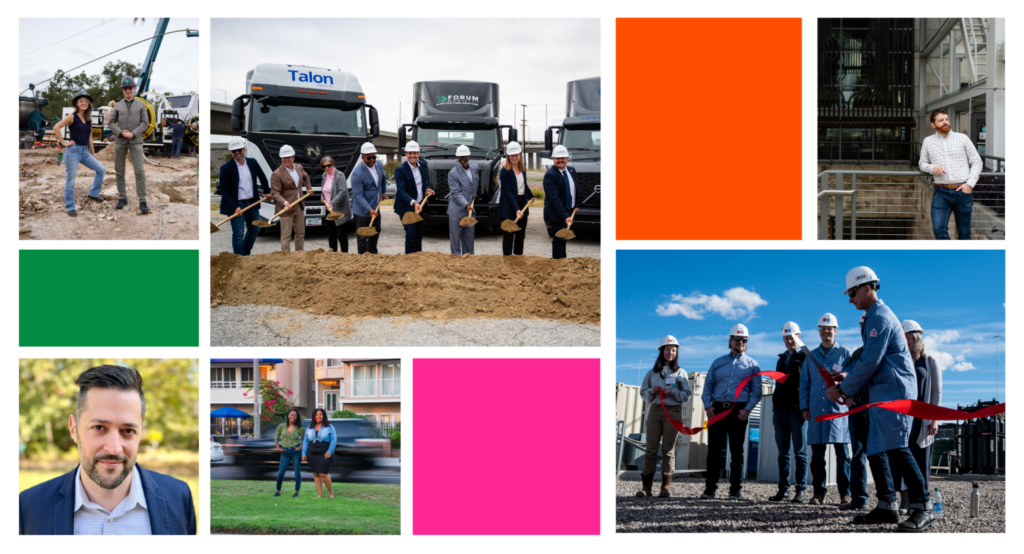
Today marks the two year anniversary of the Inflation Reduction Act (IRA). As an investor across climate tech sectors, our team has seen firsthand how the IRA has created impact in communities across the country – hundreds of thousands of jobs – while supporting new company growth. And other investors are taking note. Rhodium Group reports that investments in manufacturing and deploying clean technologies have nearly doubled in two years, reaching almost half a trillion dollars.
One key program within the IRA is the Environmental Protection Agency’s $27 billion dollar Greenhouse Gas Reduction Fund (GGRF). After announcing the winning GGRF coalitions earlier this year, the EPA reached another milestone today: the full $27B in GGRF funds have been obligated, officially opening the gates for this funding to flow to low-income and other underserved communities. We are energized to collaborate with the winning coalitions as a GGRF subawardee, and with our whole ecosystem, to make this historic program successful.
To celebrate the anniversary, we are thrilled to introduce Adrian Deveny, our newest Policy Fellow who will support Elemental in assessing federal policy opportunities that support innovation and community impact. In the Q&A below, Adrian dives into lessons learned from his 13 years in the U.S. Senate where he led negotiations on the IRA and other key climate bills.
When we asked him what his goals are for our work together he said, “One of my frustrations working on Capitol Hill is that there was often a blind spot in policy development for innovation. What I mean by that is that policymakers usually write clean energy policy to deploy technology as it is, and focus less on deploying technology that is on the cusp of commercialization. When we miss those technology breakthroughs, we can inadvertently create barriers for new technologies to compete and succeed.”
“When we miss those technology breakthroughs, we can inadvertently create barriers for new technologies to compete and succeed.”
Read on for more insights from our conversation with Adrian.
_________
You were working in the US Senate at the time the IRA passed and were instrumental to negotiating this landmark legislation. What has surprised you the most in the last two years in the rollout and implementation?
Adrian: There is always a lot of frustration around the implementation of any law. Things don’t necessarily go exactly as expected, and things can take longer than expected. But honestly, the biggest surprise has been how quickly the clean energy industry was able to respond to the IRA and grow. In the manufacturing sector in particular, I did not expect such a torrent of announcements to build new battery, solar, wind, and other clean energy manufacturing facilities across the country immediately after the IRA passed—and those announcements have just kept coming. It’s great to see.
What would you say are the key wins of the IRA and what does success look like in two years from today?
Adrian: We are seeing some really encouraging growth in solar projects. Last year was a record-breaking year for new utility-scale and residential solar projects coming online. That momentum is not guaranteed, but the good news is that we have some IRA programs that are going to come online soon, like the GGRF. I expect we’ll see the impact from the GGRF and other grant and loan programs in the IRA over the next two years. So what will success look like? It will look like more clean energy projects in lower-income communities, and more innovative technologies emerging due to support from the DOE loan program, or DOE’s industrial demonstrations program.
The other important element of success will be the resilience of the IRA to Republican opposition. When the bill first passed, it had uniform opposition from the Republican party. Now, as the clean energy economy is creating jobs in every state in the country, we are starting to see evidence of some bipartisan support for certain clean energy provisions in the IRA. We still have a long way to go, but my hope is that, over time, the IRA will help build a strong bipartisan coalition in support of all forms of climate tech.
What do you wish people in the climate tech ecosystem knew about the IRA and its implementation that often goes overlooked?
Adrian: A year ago, I would have said the GGRF needed more attention, because that program was the largest grant program in the IRA and yet very few people in the climate tech world had ever heard of it. Now, it seems there is much more awareness than there used to be.
Generally speaking, the IRA is a massive bill with well over a hundred separate programs to reduce emissions and build out a supply chain for clean energy in this country. The focus from the climate tech community is typically on the tax credits, which is understandable, but between the infrastructure bill and the IRA, there are easily over $200 billion in grant programs that could be relevant to the climate tech community. I am very sympathetic to the challenges of navigating all of these programs—it can feel overwhelming and grants and loans involve uncertainty and bureaucracy that can be hard for start-ups to manage. But I’d encourage folks to look at all the great programs in the IRA because non-dilutive capital should be very appealing.
How do you think the IRA has changed the landscape in the US for climate tech innovators and how should they think about navigating both the IRA and this new era of investment in climate tech as it takes full effect from here through 2030?
Adrian: The IRA is injecting so much money into the clean economy that, if innovators aren’t taking advantage of the programs, there’s a good chance their competitors are. As they say, if you’re not at the table, you’re probably on the menu. So it’s worth taking a hard look at how the IRA can benefit your business.
Some of the ways in which the IRA is being implemented by agencies is also forcing companies to rethink their business models in order to capture the IRA incentives. The hydrogen tax credit is just one example, where very few people would have anticipated the specificity of the Treasury rules around hydrogen and so a lot of companies that made big plans to invest in hydrogen projects are now having to rethink project designs.
The GGRF, is about to officially get started this Fall. How do you see it changing the financing landscape for climate tech innovators?
Adrian: The GGRF is one of the most exciting provisions in the IRA. The hope of the GGRF is to tackle one of the toughest decarbonization challenges—how to bring clean energy projects to lower-income communities. The vision of the GGRF was to try and solve this problem through innovative financing by capitalizing a variety of national, regional, and local “green banks” because the Federal government is not in the best position to directly fund these types of projects. For the GGRF to succeed, however, it will need climate tech innovators to bring creative project ideas and business models to these green banks that solve the tough challenges to decarbonization, especially in low-income communities. It will be very exciting to watch that program unfold.
“For the GGRF to succeed, however, it will need climate tech innovators to bring creative project ideas and business models to these green banks that solve the tough challenges to decarbonization, especially in low-income communities. It will be very exciting to watch that program unfold.”
BONUS: Why did you decide to work as an Elemental Policy Fellow now? What are your goals for this next chapter of working together?
Adrian: What I love about Elemental is that you are on the front lines of working directly with entrepreneurs not only to deploy their tech, but to solve these types of policy problems. My goal in working with Elemental is to think about how the next phase of Federal climate policy could supercharge technology innovation and accelerate the commercialization of breakthrough ideas in climate tech.




